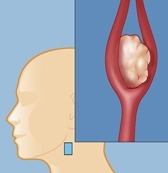Carotid Body Tumor
Savanna Rosenbaum - OMS III
What is a Carotid Body Tumor?
A carotid body tumor is a growth in your neck located next to the carotid artery, which is the vessel that carries blood to parts of your brain and face. This type of tumor is also known as a paraganglioma or chemodectoma. It grows right at the point where your carotid artery bifurcates or splits into two branches, your internal carotid artery and your external carotid artery. This is often the location of the carotid body, a group of sensors that is responsible for sending chemical signals to your brain based on levels of oxygen, carbon dioxide, and acidity in your blood. Carotid body tumors are usually not cancerous, but they do grow and can become large enough to compress important structures in your neck
What are the Symptoms?
Carotid body tumors are often asymptomatic and unnoticed by the patient. However, you can start to have symptoms as the tumor grows larger. These symptoms include difficulty swallowing, hoarseness, loss of sensation in the tongue, high blood pressure, and others. It may just be a painless mass that you can feel on the side of the neck.
Who is at Risk?
There are three types of carotid body tumors: sporadic, familial, and hyperplastic. The majority are sporadic, meaning they can occur randomly in a patient without cause. Some patients may have a familial risk factor as a smaller percentage of these tumors have a genetic inheritance. The hyperplastic type of carotid body tumors are seen more frequently in patients in chronic states of low oxygen such as those that live at high altitudes or those with medical conditions like cyanotic heart disease or chronic obstructive pulmonary disease (COPD).
What are the Treatment Options?
Treatment of carotid body tumors is based on the age and heath of the patient, the size of the tumor, whether the tumor is bilateral (on both carotids), and patient preference. Due to the ability of these tumors to grow and compress vital structures in the neck, the treatment of choice is usually surgical removal of the tumor. Radiation therapy is rarely used, mostly for patients who are poor surgical candidates or have other specific circumstances. The effectiveness of radiation is debated, so it is not recommended as an alternative for patients that have surgery as an option. The risks of the operation are directly related to the size of the tumor and the degree that other structures like nerves and blood vessels in the neck are involved. Extensive imaging is done prior to the surgery to assess a patient’s risk and help them prepare for the success and possible complications of the surgery.
Go Back A carotid body tumor is a growth in your neck located next to the carotid artery, which is the vessel that carries blood to parts of your brain and face. This type of tumor is also known as a paraganglioma or chemodectoma. It grows right at the point where your carotid artery bifurcates or splits into two branches, your internal carotid artery and your external carotid artery. This is often the location of the carotid body, a group of sensors that is responsible for sending chemical signals to your brain based on levels of oxygen, carbon dioxide, and acidity in your blood. Carotid body tumors are usually not cancerous, but they do grow and can become large enough to compress important structures in your neck
What are the Symptoms?
Carotid body tumors are often asymptomatic and unnoticed by the patient. However, you can start to have symptoms as the tumor grows larger. These symptoms include difficulty swallowing, hoarseness, loss of sensation in the tongue, high blood pressure, and others. It may just be a painless mass that you can feel on the side of the neck.
Who is at Risk?
There are three types of carotid body tumors: sporadic, familial, and hyperplastic. The majority are sporadic, meaning they can occur randomly in a patient without cause. Some patients may have a familial risk factor as a smaller percentage of these tumors have a genetic inheritance. The hyperplastic type of carotid body tumors are seen more frequently in patients in chronic states of low oxygen such as those that live at high altitudes or those with medical conditions like cyanotic heart disease or chronic obstructive pulmonary disease (COPD).
What are the Treatment Options?
Treatment of carotid body tumors is based on the age and heath of the patient, the size of the tumor, whether the tumor is bilateral (on both carotids), and patient preference. Due to the ability of these tumors to grow and compress vital structures in the neck, the treatment of choice is usually surgical removal of the tumor. Radiation therapy is rarely used, mostly for patients who are poor surgical candidates or have other specific circumstances. The effectiveness of radiation is debated, so it is not recommended as an alternative for patients that have surgery as an option. The risks of the operation are directly related to the size of the tumor and the degree that other structures like nerves and blood vessels in the neck are involved. Extensive imaging is done prior to the surgery to assess a patient’s risk and help them prepare for the success and possible complications of the surgery.
